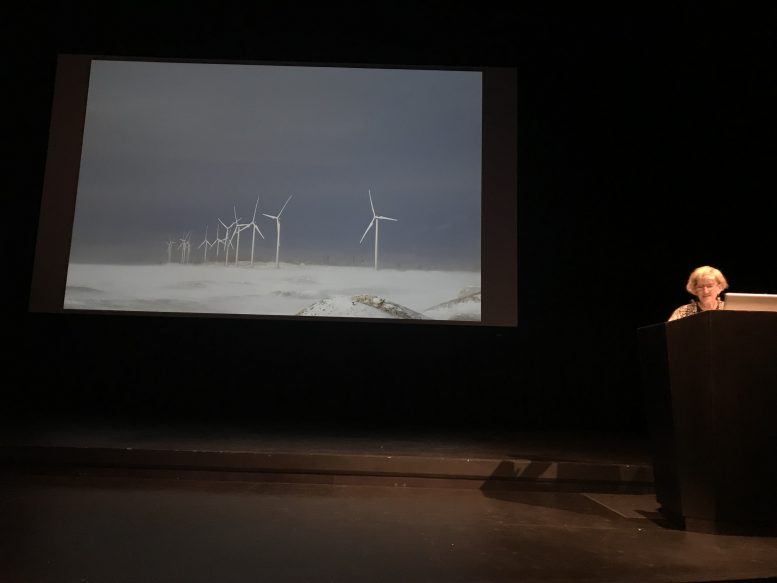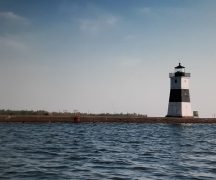By DAVID DUPONT
BG Independent News
Linda Butler will go to great lengths to snap a photograph, even having a friend drive her around the interstate near the Marathon Refinery south of Detroit. Then when the light is right, they pull over in time for her to click one frame.
The resulting photo is a masterpiece of industrial photography, the refinery caught ablaze in the sunset, plumes of smoke rising into the pale blue sky.
The resulting photograph is now on exhibit as part “Lake Erie: On the Edge,” in the Wankelman Gallery in the Fine Arts Center on the Bowling Green State University campus.
The title card explains the other side of the photo’s beauty. Those clouds of smoke are deadly. Residents in the southwestern section of Detroit, near this and a number of other plants, suffer from “excessive rates of asthma and lung cancer.”
Both the process of producing the 139,000 barrels of refined oil daily, and then the use of that oil contributes to climate change.

While the title of the show may imply nature photography, it’s subject is really the nature of the impact of human activity along the lake. The title is double-edged. Butler traveled around the edges of the lake capturing these images. To get them she placed herself in the lake, from frozen shores, from high above. Those images capture a lake, and by extension the world, on the edge of destruction.
Butler said in a recent artist’s presentation marking the opening of the exhibit that she was inspired to take on the project by the toxic algae bloom that poisoned the water for much of the Toledo area in 2014. The first slide she showed was a NASA image of the deep green algae clogged water.
Even this, she said, had a certain beauty. So the Cleveland-based photographer set about traveling around the lake, both on the American and Canadian sides, to document the current state of Lake Erie.
They include her favorite photograph in the exhibit “Luminescence,” a rare image of a lake so tranquil, with a layer of submerged ice, that it reflects the sky.
Another is a dramatic photo of plants frozen along the lake shore in Eastlake. Rapidly dropping temperatures, Butler explained, caused the water splashing on the shore to freeze instantly, encasing the plants and a stop sign in ice.
The human touch is never far removed from her work.
Even a shot of mergansers is taken on the murky, half frozen Cuyahoga River as it flows through Cleveland.
There’s also a dramatic image of a wave, taken by the photographer as she was standing in the water. Butler, who is in her early 70s, assured the audience that the angle made the wave appear much larger than it was, and that she was in no danger.
Butler also took to the air to document the development of alternative sources of energy meant to replace that oil. She contrasted Canada’s aggressive push to develop wind and solar power with Ohio’s stringent regulations governing the installation of turbines.
One ghostly image taken in frigid winter temperatures shows a dozen or so wind turbines constructed on the slag heap left from a former steel plant on the eastern shore of Lake Erie.
The algae bloom is what helped spur her to create this body of work, the threat to the globe by climate change asserted itself as she progressed.
Both the algae and climate change, which she refers to as “global weirding,” are “intractable problems,” she said. They are related as the carbon dioxide produced by coal plants traps heat in the atmosphere. The weather becomes “weird … global weirding.”
These issues come together in her images of a Lucas County farm owned by Stephen Loeffler.
These show lush green fields. Fields made green by the application of fertilizer, including liquid manure. The phosphorus from fields like these throughout the Maumee River watershed washes into the lake fostering the growth of algae.
Loeffler injects fertilizer below the surface of the soil so it is less apt to run off.
Heavy rains are now more likely, Loeffler told Butler. When he was young he said he didn’t remember getting rains that dumped three to four inches in a day. That just worsens the run off from the fields.
One solution is the preservation of wetlands. These can hold and filter the phosphorus, lessening its impact.
“If we want more wetlands,” Butler said, “the government needs to subsidize farms for taking farmland out of production.”
The images of the green mid-summer fields contrast though with the really of this growing season. Loeffler who attended Butler’s BGSU talk, said he like other local famers was not able to get his corn crop panted because of heavy and persistent rain in the spring.
Butler concluded her talk with a plea. “Fresh water is the most important resource because we can’t live without it. We must treat this resource as the treasure that it is and be aware of how tenuous it’s availability is throughout the world.”
***
The exhibits “Lake Erie: On the Edge,” photography by prize-winning fine arts photographer Linda Butler, in the Wankelman Gallery and “The Great Lake Erie,” photography by Frank Gohlke and Lynn Whitney, BGSU’s head of photography, in the Bryan Gallery lobby, are on display through Nov. 24. Gallery hours are Tuesday-Saturday 11 am. to 4 p.m., Thursday 7 to 9 p.m. and Sunday 1 to 4 p.m.





